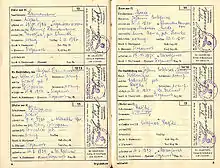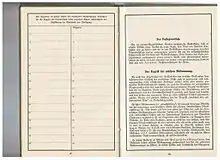Ahnenpass
The Ahnenpaß (literally, "ancestor pass") documented the Aryan lineage of people "of German blood" in Nazi Germany. It was one of the forms of the Aryan certificate (Ariernachweis) and issued by the "Reich Association of Marriage Registrars in Germany" (Reichsverband der Standesbeamten in Deutschland e. V.).[1]

.pdf.jpg.webp)


The term Aryan in this context was used in a sense widely accepted in the "race science" of the time, which considered that there was a Caucasian race which was sub-divided into Semitic, Hamitic, and Aryan (Japhetic) subraces, the latter corresponding to the Indo-European language family. The Nazi ideology limited the category Aryan to certain subgroups, while excluding Slavs as non-Aryan. The actual primary objective was to create extensive profiling based on racial data.
The investigation for lineage was not obligatory, as it was a major undertaking to research the original documents for birth and marriage. Many Nazi followers had already begun to research their lineage even before law required it (soon after the NSDAP took power on 30 January 1933).
One important law, issued on 7 April 1933 (after the Nazi assumption of power) was called the Law for the Restoration of the Professional Civil Service, and it required all public servants to be of Aryan descent. The law, however, did not define the term "Aryan" and a subsequent regulation was issued on 11 April as the first legal attempt by the Nazi government to define who was, and who was not, a Jew. Germans aspiring for the document had to prove they were of Aryan descent.[2] The Ahnenpass could be issued to citizens of other countries if they were of "German blood",[3][4] and the document stated that Aryans could be located "wherever they might live in the world"[4][5] The Reichsgesetzblatt (Reich Legislative Gazette) referred to people of "German or racially related blood" rather than just "of German blood".[6]
The many Poles, Czechs and others of German descent in other countries were known as Volksdeutsche, and Aryan. Poles and Czechs not of German descent, and other Slavs, were not considered Aryans by Nazi Germany[7][8][9][10][11][12][13][14][15][16][17][18][19][20][21] A definition of Aryan that included all non-Jewish Europeans was deemed unacceptable by Nazis, and the Expert Advisor for Population and Racial Policy included a definition defining Aryan as someone who is "tribally" related to "German blood"[22]
The implementing decree followed the pre-Nazi trend found in the Aryan Paragraph[23] and read in pertinent part that:
„Als nicht arisch gilt, wer von nicht arischen, insbesondere jüdischen Eltern oder Großeltern abstammt. Es genügt, wenn ein Elternteil oder ein Großelternteil nicht arisch ist. Dies ist insbesondere dann anzunehmen, wenn ein Elternteil oder ein Großelternteil der jüdischen Religion angehört hat.“
Those are not Aryans who descend from non-Aryan, especially Jewish, parents or grandparents. It is sufficient (grounds for exclusion) for one parent or grandparent to be non-Aryan. This is particularly assumable if a parent or grandparent adhered to the Jewish religion.
The applicable fields were later enlarged under different laws to include lawyers, teachers, and medical doctors, and required a proven Aryan lineage even to attend high school or get married. Usually, the lineage was investigated two generations back. The Ahnenpass cost 0.6 Reichsmarks.
Holding an Ahnenpass was not on record; the document was shown whenever proof of Aryan descent was required.
Due to the need for Ahnenpasses, genealogical research flourished in Nazi Germany. Opposition clergy helped many racially persecuted individuals by providing them with false certificates of ancestry necessary for survival.
See also
References
Notes
- Cornelia Schmitz-Berning (2007): Vokabular des Nationalsozialismus. Walter de Gruyter, p. 20. ISBN 3-11-013379-2.
- Schweikardt, Chrtistoph (2004). ""You Gained Honor for Your Profession as a Brown Nurse:" The Career of a Nationalist Socialist Nurse Mirrored by Her Letters Home". Nursing History Review. American Association for the History of Nursing. 12: 130. doi:10.1891/1062-8061.12.1.121. ISBN 9780826114655. PMID 14608850.
- Cornelia Schmitz-Berning (1 January 2007). Vokabular des Nationalsozialismus. Walter de Gruyter. p. 61. ISBN 978-3-11-092864-8.
- Christopher J. Wells (1 January 1990). Deutsch: Eine Sprachgeschichte bis 1945. Walter de Gruyter. p. 447. ISBN 978-3-11-091484-9.
- Scheil, Stefan. "Aryans". JUNGE FREHEIT.
Quotation in German: z.B. ein Engländer oder Schwede, ein Franzose oder Tscheche, ein Pole oder Italiener.
- Original: "deutsches oder artverwandtes Blut"; Reichsgesetzblatt 1939 I p. 2042, § 6.
- Historical Dictionary of the Holocaust - Page 175 Jack R. Fischel - 2010 The policy of Lebensraum was also the product of Nazi racial ideology, which held that the Slavic peoples of the east were inferior to the Aryan race.
- Hitler's Home Front: Wurttemberg Under the Nazis, Jill Stephenson p. 135, Other non-'Aryans' included Slavs, Blacks and Roma .
- Race Relations Within Western Expansion - Page 98 Alan J. Levine - 1996 Preposterously, Central European Aryan theorists, and later the Nazis, would insist that the Slavic-speaking peoples were not really Aryans
- The Politics of Fertility in Twentieth-Century Berlin - Page 118 Annette F. Timm - 2010 The Nazis' singleminded desire to "purify" the German race through the elimination of non-Aryans (particularly Jews, Gypsies, and Slavs)
- Curta 2001, p. 9, 26–30.
- Bergman, Jerry (June 1992). "Eugenics and the Development of Nazi Race Policy". Perspectives on Science and Christian Faith. 44 (2): 0109–124.
- Götz Aly, Peter Chroust, Christian Pross, Cleansing the Fatherland: Nazi Medicine and Racial Hygiene, The Johns Hopkins University Press, (August 1, 1994) ISBN 0-8018-4824-5
- Berenbaum, Michael; Peck, Abraham J., eds. (1998). The Holocaust and History The Known, the Unknown, the Disputed, and the Reexamined. Indiana University Press. p. 59. ISBN 0253215293.
- Bartulin, Nevenko (2013). Honorary Aryans: National-Racial Identity and Protected Jews in the Independent State of Croatia. Palgrave Macmillan. p. 7. ISBN 9781137339126.
According to Jareb, the National Socialists regarded the Slavs as 'racially less valuable' non-Aryans
- Tames, Richard (1985). Nazi Germany. p. 65.
- Modern Genocide: The Definitive Resource and Document Collection Paul R. Bartrop, Steven Leonard Jacobs page 1160, "This strict dualism between the "racially pure" Aryans and all others—especially Jews and Slavs—led in Nazism to the radical outlawing of all "non-Aryans" and to their enslavement and attempted annihilation"
- World Fascism: A Historical Encyclopedia, Volume 1 Cyprian Blamires page 63 "the "racially pure" Aryans and all others—especially Jews and Slavs— led in Nazism to the radical outlawing of all "non-Aryans" and to their enslavement and attempted annihilation
- Rodriguez, Junius P. (1997). The Historical Encyclopedia of World Slavery, Volume 1; Volume 7. p. 464. ISBN 9780874368857.
- Patterson, David (14 March 2008). Emil L. Fackenheim: A Jewish Philosopher's Response to the Holocaust. p. 23. ISBN 9780815631835.
- Fischel, Jack R. (15 April 2020). Historical Dictionary of the Holocaust. p. 222. ISBN 9781538130162.
Lebensraum was also the product of Nazi racial ideology, which held that the Slavic peoples of the east were inferior to the Aryan race
- Ehrenreich, Eric (2007). The Nazi Ancestral Proof: Genealogy, Racial Science, and the Final Solution. Indiana University Press. pp. 9, 10. ISBN 978-0-253-11687-1.
- The Nuremberg Laws would eventually supersede the "one grandparent" rule and would establish new rules of race for the Third Reich.
Bibliography
- Curta, Florin (2001). The Making of the Slavs: History and Archaeology of the Lower Danube Region, c. 500–700. Cambridge: Cambridge University Press. ISBN 9781139428880.CS1 maint: ref=harv (link)
Further reading
- Der Ahnenpaß des Ehepaares. Verlag für Standesamtswesen, Berlin 1939.
- Eric Ehrenreich: The Nazi Ancestral Proof: Genealogy, Racial Science, and the Final Solution. Bloomington, IN: Indiana University Press, 2007. ISBN 978-0-253-34945-3
- Cornelia Essner: Die „Nürnberger Gesetze“ oder Die Verwaltung des Rassenwahns 1933–1945. Schöningh, Paderborn 2002, ISBN 3-506-72260-3.
- Nicholas John Fogg, 'German genealogy during the Nazi period (1933-1945)', in Genealogists' Magazine, vol. 30, no. 9 (London, March 2012) pages 347-362.
- Christian Zentner, Friedemann Bedürftig (1991). The Encyclopedia of the Third Reich, p. 23. Macmillan, New York. ISBN 0-02-897502-2